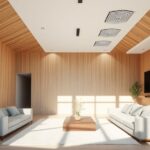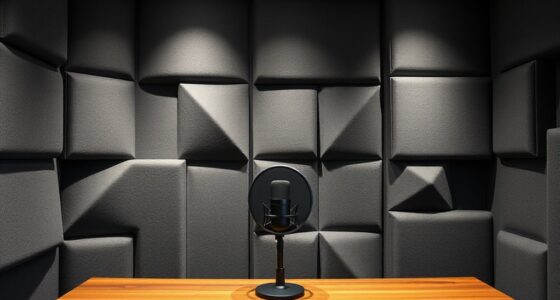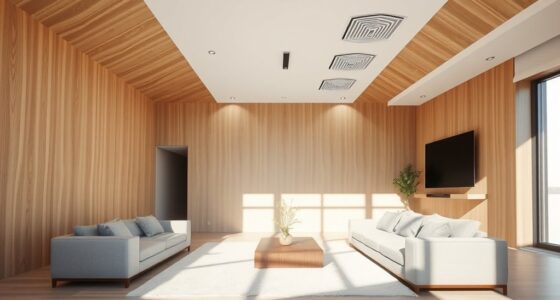To achieve balanced sound with ceiling treatments, combine acoustic panels with decorative beams. Install fabric-wrapped panels in strategic spots to absorb excess noise, and use wood or faux beams to diffuse sound and add style. Gridding or patterning the beams creates visual interest while enhancing acoustics. By blending these elements thoughtfully, you’ll create a room that looks great and sounds comfortable. Keep exploring to discover more tips for perfecting your space’s sound and style.
Key Takeaways
- Strategically place acoustic panels near reflective surfaces to absorb excess sound and reduce echo.
- Incorporate decorative beams in patterns like grid or crosswise layouts to diffuse sound waves.
- Combine fabric-wrapped acoustic panels with wood or faux wood beams for visual contrast and acoustic layering.
- Frame and embed acoustic panels into ceiling designs for a sleek, integrated look that enhances sound control.
- Use a mix of textures, colors, and materials to balance aesthetics with effective sound absorption and diffusion.

A stunning ceiling treatment can transform any room from ordinary to extraordinary. When you’re aiming for a space that balances sound perfectly, your ceiling choice plays a pivotal role. Acoustic panels are an excellent option to contemplate because they serve a dual purpose: enhancing the room’s acoustics while adding a stylish element. You can install these panels directly onto the ceiling surface, choosing from various designs, colors, and textures to match your decor. Not only do they absorb excess sound, reducing echoes and background noise, but they also give your room a sleek, modern appearance. For a more integrated look, consider panels that blend seamlessly with your ceiling or are framed as decorative accents. This way, you achieve functional sound control without sacrificing style.
Decorative beams are another impactful ceiling treatment that marries aesthetics with acoustic benefits. Whether you opt for wood, faux wood, or painted beams, they create visual interest and can make your ceiling appear higher and more dynamic. Beams can be installed in various patterns—parallel, crosswise, or in a grid—to add texture and depth. Beyond their visual appeal, beams can help with sound diffusion, breaking up sound waves and preventing them from bouncing around the room uncontrollably. If you want a more rustic or traditional look, exposed wooden beams can do the trick, but they can also be painted or finished to fit contemporary styles. Combining decorative beams with acoustic panels can give you a unique, layered ceiling that not only looks stunning but also improves sound quality markedly. Additionally, understanding sound diffusion techniques can help you optimize your ceiling design for balanced acoustics.
Decorative beams add visual interest and help diffuse sound for a dynamic, stylish ceiling.
When you’re designing your ceiling treatment for balanced sound, think about placement and integration. For example, acoustic panels work best when strategically placed where sound tends to bounce or echo, such as near reflective surfaces or hard floors. Incorporating them into decorative beams or framing them as part of a beam design creates a cohesive look that doesn’t feel purely functional. You might also consider combining different materials—like fabric-wrapped panels with wood beams—to add contrast and texture. The key is to strike a balance where aesthetics enhance your room’s personality without compromising its acoustic performance.
Ultimately, a well-thought-out ceiling treatment elevates your space both visually and acoustically. By choosing the right combination of acoustic panels and decorative beams, you can create an environment that’s not only beautiful to look at but also offers comfortable, balanced sound. With these ideas, you’re well on your way to transforming your room into a sanctuary of style and acoustic harmony.
Frequently Asked Questions
What Materials Are Best for Soundproof Ceiling Treatments?
You should choose materials like acoustic panels and soundproof drywall for effective ceiling treatments. Acoustic panels absorb sound waves, reducing echo and noise, while soundproof drywall adds mass to block sound transmission. Combining these materials enhances soundproofing and creates a balanced acoustic environment. Make sure to install them properly for ideal results, and consider adding insulation or resilient channels for even better sound control.
How Do Ceiling Treatments Affect Room Acoustics Long-Term?
Ceiling treatments act like a sponge for sound, absorbing noise and reducing echoes over time. You’ll notice that your room feels more balanced, with less reverberation and clearer voices. Properly installed treatments boost sound absorption, leading to a calmer environment. Long-term, they help sustain acoustic quality, making conversations easier and music richer. Regular maintenance ensures these benefits last, keeping your space comfortable and acoustically tuned for years.
Can Ceiling Treatments Improve Sound Quality in Open-Plan Spaces?
Yes, ceiling treatments can improve sound quality in open-plan spaces. You should consider installing acoustic panels on the ceiling to enhance sound absorption, reducing echoes and noise distraction. These panels help control sound reflections and create a more balanced environment. By strategically placing acoustic treatments, you can make the space more comfortable, clearer, and better suited for conversations, work, or relaxation, even in large open areas.
Are There Eco-Friendly Options for Ceiling Sound Treatments?
Your search for eco-friendly ceiling sound treatments is as exciting as finding a hidden treasure! You can opt for biodegradable materials like hemp, cork, or recycled cellulose, which are fantastic recycling options that reduce environmental impact. These materials absorb sound effectively while being kind to the planet. Plus, they’re sustainable choices, helping you create a greener, healthier space without sacrificing style or acoustic performance.
How Much Do Professional Ceiling Soundproofing Installations Typically Cost?
You can expect professional ceiling soundproofing installation costs to range from $1,000 to $4,000, depending on various cost factors. These include the size of your space, the type of soundproofing materials used, and the complexity of the installation process. To get an accurate estimate, consider consulting with specialists who can assess your specific needs and provide detailed quotes based on installation costs and project scope.
Conclusion
Now that you’ve explored these ceiling treatment ideas, imagine transforming your space into a symphony of perfect sound. Just as a conductor guides an orchestra, your choices can harmonize acoustics and style seamlessly. Don’t be afraid to experiment—your ideal balance of sound and design is within reach. After all, the ceiling isn’t just a top surface; it’s the canvas where your soundscape begins. Let your creativity soar and create a space that sings with harmony.















